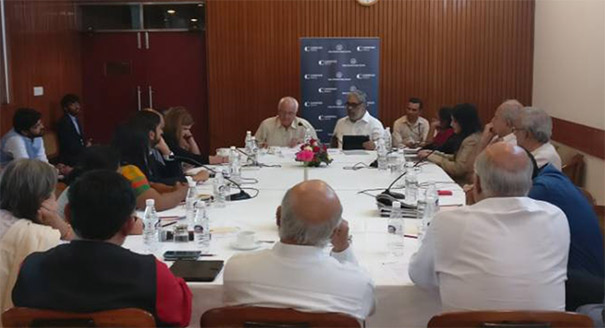Registration
You will receive an email confirming your registration.
Buddhism’s principles and values transcend borders to bind people across Asia within a common cultural heritage. Its inclusive philosophy and reach across the Asian continent has the potential to draw countries closer in order to explore their shared legacy and heritage. Regional cooperation to promote connectivity and infrastructure projects has great economic potential. Through multilateral initiatives, Buddhism could serve as the catalyst that deepens the connection of hearts and minds across Asia. Carnegie India, in association with the India International Center, hosted Kathmandu-based journalist Kanak Mani Dixit for a roundtable discussion on the Buddhas of Kapilvastu.
DISCUSSION HIGHLIGHTS
- The Kapilvastu Region: Located in the plains of central Nepal, and extending across the present India-Nepal border, the district of Kapilvastu holds tremendous historical significance for Buddhism. The discussion centered on historicity of the ancient Kapilvastu region, where several Buddhist pilgrimage sites relating to the Sakyamuni Buddha, as well as earlier historical Buddhas like the Kanakmuni Buddha and the Krakucchanda Buddha, are located. The discussion also examined the importance of preventing geopolitical rivalries, excessive commercialism through tourism, and ultra-nationalism. Participants emphasized that these factors should not be allowed to impact the spiritual weight of this space.
- The Threat of Commercialization: Lumbini, the birthplace of Lord Buddha, is a World Heritage Site located in central Nepal. While participants supported efforts to develop this area into a site of religious pilgrimage, and characterized tourism as a positive development, they were apprehensive of the challenges of commercialization. Participants worried that this could result in the exploitation of land and the desecration of the sanctity of its spiritual space. They suggested learning from the developmental efforts employed at other pilgrimage sites to strike a balance between offering visitors amenities, preserving the authenticity of the site, and benefiting the local Nepalese community.
- Emphasis on Historicity: Participants discussed the need for a strategy to reorient interest toward the other historical Buddhas: Kashyap Muni, who was born in Benares, Krakucchanda Muni in Gotihawa, Kanakmuni in Niglihawa, and Shakya Muni in Lumbini. Further, participants recognized the diversity of Buddhist traditions and interpretations across the continent and emphasized the importance of highlighting the extensive network of historic relics and sites of Buddhist significance across South and Southeast Asia.
- Chinese Interest: Participants noted the increased interest of the Chinese people and organizations and emphasized adopting a collaborative and multilateral strategy to explore the region’s Buddhist legacy. While Lumbini should remain open to involvement by all societies, participants were concerned by the possibility of unilateral activities. They offered as an example of this approach the expansive plan announced in 2011 by a China-based organization known as the Asia Pacific Exchange and Cooperation Foundation (APECF), a nongovernmental organization sponsored by the Chinese Communist Party. Seemingly backed by little homework, and with little participation from Nepalese stakeholders, they said, it proposed a $3 billion plan to ‘develop’ Lumbini on a massive scale into a pilgrimage destination. Following opposition from Nepal’s bureaucracy and civil society, which was concerned by the lack of transparency and consultation, the government of Nepal refused to go along with the proposed initiative. Discussants were of the view that the experience of the APECF should highlight the need for transparency in future development initiatives relating to World Heritage Sites.
- Geopolitical Drivers: Participants noted that China and India have both identified Buddhism as an instrument of soft power, while Nepal is keen to develop Lumbini for its economic value. They stressed that hyper-commercialization and ultra-nationalism should not be allowed to diminish the spiritual value of the Kapilvastu region and other locations associated with the historical Buddhas. At the same time, discussants underscored that they should not become sites of geopolitical contestation, and should be open to all seekers, Buddhist and non-Buddhist alike.
- Exploring the Legacy: Participants suggested that countries could come together to jointly develop the shared heritage of Buddhism. This could be at the regional level through the South Asian Association for Regional Cooperation, or through multilateral projects with Buddhist countries across Asia. Significantly, the only faith-based committee under the aegis of the United Nations was the International Committee for the Development of Lumbini. Set up in 1970, it enjoyed the patronage of Afghanistan, Pakistan, Nepal, Sri Lanka, Bangladesh, Bhutan, Myanmar, India, Indonesia, China, Cambodia, Japan, the Lao People’s Democratic Republic, Malaysia, Singapore, Thailand, and the Republic of Korea. This was complimented by the Lumbini Development Committee at the national level with the aim of implementing the Master Plan for Lumbini. Participants suggested reactivating the United Nations’ International Committee in order to properly develop Lumbini, a site of importance to the world’s Buddhists, as a means to prevent hyper-commercialization, geopolitical rivalries, and the dangers of ultra-nationalism. Reactivating this organization could also be one effective way to sustainably develop and share the significance of Lumbini with the global Buddhist community.
This event summary was prepared by Arushi Kumar, a research assistant at Carnegie India, with inputs from Meghan Gable, a Boren Fellow at Carnegie India, and Soundarya Jayaraman, an intern at Carnegie India.
